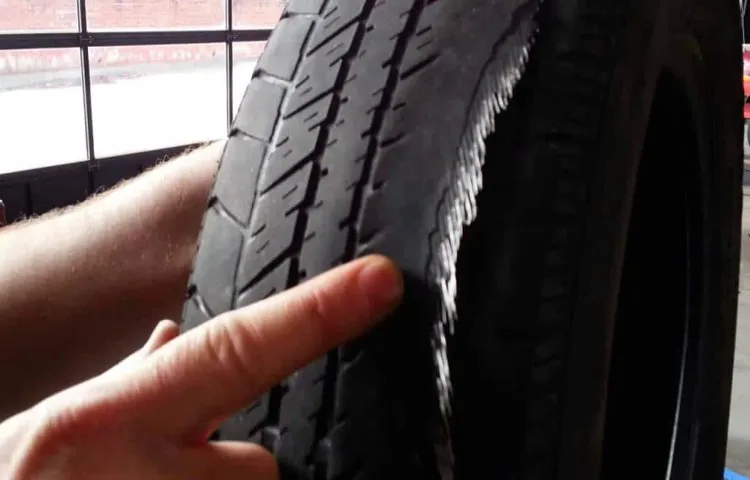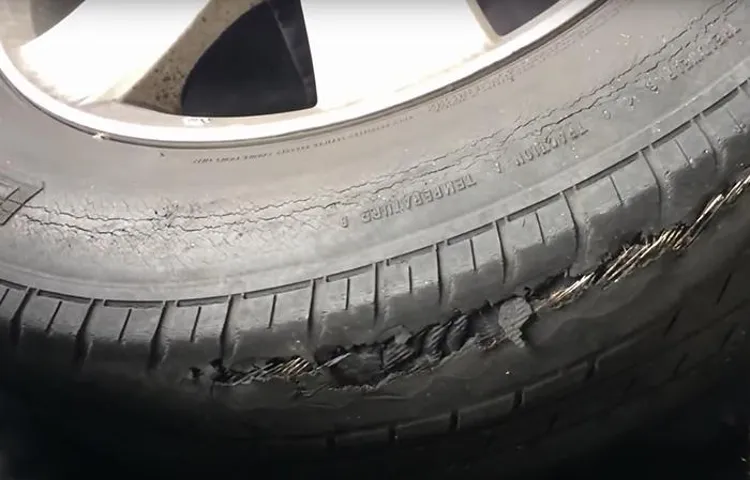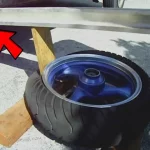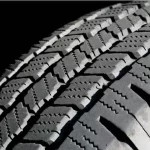Have you ever wondered how long you can drive on a tire with worn treads? It’s a common question for drivers who want to save money by putting off buying new tires. The truth is, driving on worn-out tires can be dangerous and can put you and other drivers on the road at risk. So, it’s important to know when to replace your tires for the sake of your safety.
In this blog post, we’ll discuss how long you can drive on a tire with worn treads and why it’s important to replace them sooner rather than later. We’ll provide you with helpful tips on maintaining your tires to get the most out of them. So, buckle up, and let’s get started!
Table of Contents
When to Replace Your Tires
As a responsible vehicle owner, it’s important to know when it’s time to replace your tires. If you’re wondering how long a tire will last with exposed wire, the answer is simple – it’s time for a new tire. Driving on tires with wire showing is dangerous and can result in tire blowouts, accidents, and even injuries.
Tires can last anywhere from 25,000 to 50,000 miles, depending on factors such as driving habits, road conditions, and maintenance. One way to check your tire’s wear is by doing the penny test. Place a penny between the tread grooves with Lincoln’s head facing down.
If you can see the top of his head, it’s time to replace your tire. Don’t wait until it’s too late – replace your tires as soon as they start showing signs of wear and tear. It’s better to be safe than sorry, and investing in new tires will ensure your safety on the road.
Tire Tread Wear Indicators
Tire tread wear indicators are an important aspect of tire maintenance that should not be ignored. These small, raised bars of rubber located in the tire’s grooves give a visual indication of when it’s time to replace your tires. As you drive, the tread on your tire wears down, and as it reaches the same level as the tread wear indicator, you’ll know it’s time to get new tires.
This is a critical safety feature as tires with worn-out treads can lead to reduced traction, especially in wet conditions, which can lead to hydroplaning and loss of control. Additionally, driving on tires with worn-out treads can cause your vehicle to handle poorly, which could lead to an accident. Therefore, it’s crucial to regularly inspect your tire’s tread wear indicators to determine whether it’s time to replace them.
Remember, maintaining good tire health can significantly improve your car’s handling and your safety on the road.

Tread Depth Recommendations
Tire tread depth is a crucial factor in determining when it’s time to replace your tires, and it’s essential to know the appropriate depth recommendations. The recommended minimum depth for safe driving on dry roads is 2/32 of an inch, and for wet and snowy roads, it’s 4/32 of an inch. However, it’s important to note that these recommendations are just the minimums, and it’s always best to replace your tires before they reach that point.
It’s recommended that you check your tire tread depth every six months and more frequently if you frequently drive on rough roads or in adverse weather conditions. Always be aware that worn tires with low tread depth are a hazard on the road and can lead to accidents due to poor traction and control. Remember that your safety and the safety of others on the road should be your top priority.
Signs of Tire Wear
If you’re wondering how long a tire will last with wire showing, the answer is simple: it’s time to replace it! In fact, you should have replaced it long before the wires were visible. Signs of tire wear aren’t always as obvious as wires poking through rubber, but there are things you can look for to know when it’s time for new tires. Common signs of wear include bulging, cracking, uneven wear, and low tread depth.
Failing to replace tires when they are worn can lead to decreased performance, reduced safety, and even blowouts on the road. It’s important to check your tires regularly and replace them when needed to ensure optimum performance and safety on the road.
Bumps or Bulges on Sidewalls
When it comes to tire wear, bumps or bulges on the sidewalls can be a major cause for concern. These irregularities can occur due to age, driving habits, or even improper maintenance. In any case, it’s important to address them promptly to avoid potentially dangerous blowouts or tire failures.
If you notice bumps or bulges on your tires, it’s important to inspect them closely to determine the root cause. If they appear to be caused by age or misuse, replacement may be necessary. However, if they are caused by improper maintenance, such as overloading the vehicle or improper inflation, addressing these issues may be all that’s needed to prevent further damage.
Remember, your tires are the only point of contact between your vehicle and the road, so it’s crucial to keep them in top condition.
Uneven Wear Patterns
Uneven tire wear patterns can be a sign of various issues with your vehicle or driving habits. These patterns may include wear on the edges of your tires, a worn center tread, or even diagonal wear patterns. Overinflating or underinflating your tires can cause uneven wear patterns, as can misaligned wheels or a worn suspension system.
In addition, aggressive driving and sudden stops or turns can also contribute to uneven tire wear patterns. It’s important to regularly check your tires for signs of wear and address any issues promptly to maintain your safety on the road and extend the life of your tires. By keeping your tires properly inflated, aligned, and rotating them regularly, you can prevent uneven wear patterns and ensure your vehicle runs smoothly.
Cracks in the Tires
Do you know how to spot the signs of tire wear? One of the most common indicators is the presence of cracks in the rubber, also known as dry rot. These cracks can appear on the sidewalls or treads and can be caused by a variety of factors, including exposure to sunlight, changes in temperature, and over-inflation. While small cracks may not indicate a serious problem, larger or deeper cracks can compromise the tire’s structural integrity and lead to blowouts.
It’s important to inspect your tires regularly and replace them when you notice significant wear or damage. Remember, your tires are the only part of your vehicle that touch the road, so keeping them in good condition is essential for your safety and the safety of others on the road.
When Wire Shows on Your Tires
If you can see wires poking out of your tire, it’s a clear sign that it’s time to replace it. Continuing to drive on a tire with exposed wires can be extremely dangerous and could lead to a blowout on the road. But how long can you safely drive on tires before the wires start showing? It’s difficult to give a straight answer because several factors influence tire life, such as driving habits, road conditions, and the type of tire you’re using.
However, in general, a tire should last anywhere from 25,000 to 50,000 miles before needing to be replaced. Regular maintenance and inspections can help prolong tire life, but if wire shows on your tires, it’s time for a new set. Don’t take the risk of driving on worn-out tires – prioritize your safety and replace them as soon as possible.
Can You Drive on Tires with Wire Showing?
Driving on tires with wire showing can be dangerous and should be avoided at all costs. When the metal wire from the tire’s steel belts begins to protrude through the rubber, it’s a sign that the tire has deteriorated and is beyond repair. This deterioration can be the result of various reasons such as old age, under-inflation, overloading, or hitting a pothole.
If you continue to drive on tires with wire showing, you are at risk of losing control of your vehicle, experiencing a blowout, or getting into an accident. It is important to check your tires regularly and replace them immediately if you notice any signs of wear and tear. Don’t take a chance with your safety and the safety of others on the road.
Invest in new tires to ensure optimal performance and peace of mind while driving.
How Long Can You Drive on Tires with Wire Showing?
Driving on tires with wire showing can be extremely dangerous and should be avoided at all costs. The wires that become exposed as your tires wear down can puncture and rupture the tire, leading to a blowout. This is especially true if you encounter any potholes or sharp objects on the road.
If you notice that the wires are showing on your tires, it’s crucial that you replace them immediately. It’s important to keep in mind that the wear on your tires will be uneven, and the damaged tire may not be able to provide adequate traction on the road. This can result in decreased control of your vehicle and lead to accidents on the road.
It’s imperative to ensure the safety of yourself and other drivers by replacing worn tires as soon as possible. Don’t take any chances, and have your tires checked regularly to prevent potentially dangerous situations on the road.
Conclusion
Imagine a tire as a piece of chocolate cake. At the beginning, it’s soft and fluffy, but as time goes on, it starts to wear down and eventually, the wire inside starts to show. Just like how cutting into a cake with wire inside is a dangerous game, driving on a tire with exposed wire is risky business.
So, how long will a tire last with wire showing? Let’s just say, like eating a cake with wire inside, it’s not a risk worth taking.”
FAQs
What is the danger of driving with a tire that has wire showing?
Driving with a tire that has wire showing is extremely dangerous. It increases the risk of a blowout, which can cause a loss of control of the vehicle and potentially lead to an accident.
How long can a tire last with wire showing before it needs to be replaced?
It is not safe to continue driving on a tire with wire showing. The tire should be replaced immediately. Driving on a tire with wire showing can cause it to fail at any moment, which can lead to a serious accident.
Can a tire with wire showing be repaired?
No, a tire with wire showing cannot be repaired. The damage is too severe and the tire is considered beyond repair. It needs to be replaced.
How can I prevent my tires from wearing down to the point where wire is showing?
Regular tire maintenance is key to preventing severe wear and tear on your tires. This includes rotating your tires regularly, keeping them properly inflated, and checking for signs of wear and damage.
Are there any warning signs that my tires may have wire showing?
Yes, there are several warning signs that your tire may have wire showing. These include unusual vibrations or noises while driving, uneven tire wear, and bulges or cracks in the tire. If you notice any of these signs, it is important to have your tires inspected by a professional.
What should I do if I notice wire showing on my tire while driving?
If you notice wire showing on your tire while driving, it is important to pull over immediately and replace the tire. Continuing to drive on the tire can be extremely dangerous and can lead to an accident.
How much does it cost to replace a tire with wire showing?
The cost to replace a tire with wire showing can vary depending on several factors, including the type of vehicle and the type of tire needed. It is important to have the tire replaced as soon as possible, as driving on a tire with wire showing is extremely dangerous.



